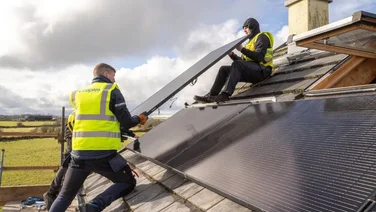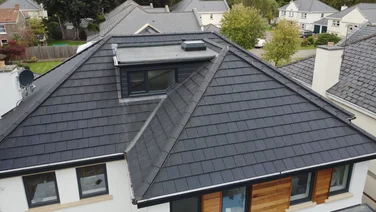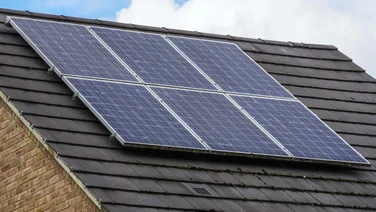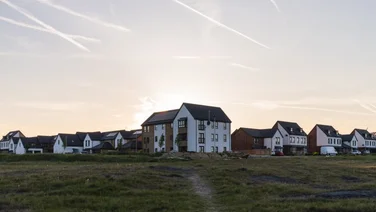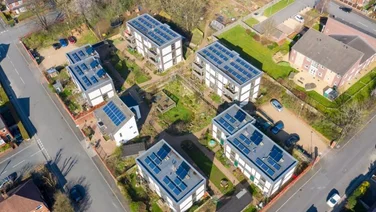- Rent-a-Roof lets you benefit from solar power for reduced prices
- A 3.5 kilowatt solar system can save you thousands of pounds
- Solar panels reduce your carbon emissions
The Rent-a-Roof scheme has declined in popularity ever since the government’s Feed-in Tariff (FiT) ended in 2019.
Back then, it was financially attractive for installers to offer free solar panels because they made their money back by claiming the government’s feed-in tariff payments, but the Feed-in Tariff has been replaced by other government grants, incentives and funding schemes.
The scheme does still exist for those that can’t afford the upfront cost, but the number of installers offering it is limited. We’ve explained everything you need to know about the Rent-a-Roof scheme here.
If you’re ready to buy solar panels for your home outright, fill in our short form. All you need to do is enter a few details and our trusted suppliers will get back to you with quotes.
Where do you want to install solar panels?
Get started
What is a solar panel Rent-a-Roof scheme?
The Rent-a-Roof scheme lets people who can’t otherwise afford solar panels gain access to them, through installers who will setup solar panels on roofs for reduced prices.
Installers can then sell any excess electricity generated back to the grid. Technically, they’re not paying rent for your roof, because you’ll get the benefit of powering your home using solar power instead of grid electricity. They’ll make money from the electricity you don’t use.
All excess electricity generated is sold back to the grid via the Smart Export Guarantee (SEG) scheme. The SEG was set up to get energy suppliers to pay households (or in this case, installers) for any renewable energy they generate, but don’t use.
Why are rent-a-roof schemes less popular now?
In 2010 when the government first launched its Feed-in Tariff funding for solar panels, the tariff payments were so generous that many installers were able to offer free solar panels through a Rent-a-Roof scheme.
This suited many homeowners, as the average cost of a 4 kW solar system in 2010 was over £15,000.
Costs for solar power have plummeted since then. You can now get a 3.5 kW system for £7,026. Because of this, many installers have stopped offering the Rent-a-Roof scheme as it’s no longer as lucrative to sell electricity back to the grid.
Some installers do still offer Rent-a-Roof for people who can’t afford solar panels. With the smallest solar systems — typically 1 kW — costing £1,630 on average, it is still quite expensive for many.
Where do you want to install solar panels?
Get started
Advantages and disadvantages of rent-a-roof schemes
| Advantages | Disadvantages |
|---|---|
| Rent-a-Roof lets you power your home using renewable energy, for free | Far fewer installers offer the scheme because it’s better to buy solar panels outright now |
| You can reduce your monthly energy bill by 49% on average | All money made from exporting excess electricity goes to the installers |
| Solar panels help reduce your carbon footprint | You can be held liable for missed payments if the solar panels break and it’s deemed your fault, or you need to remove the panels for roof repairs or maintenance |
The Rent-a-Roof scheme remains a good option if you cannot afford solar panels or don’t want to take out a loan. Unfortunately, so few installers now offer the scheme that purchasing or taking out a loan for solar panels is likely the best option.
Solar panel prices will continue to decrease as technology improves as well. This means Rent-a-Roof will become more insignificant with each passing year, because more people will be able to afford their own solar systems.
How much money can you earn from a rent-a-roof scheme?
All revenue generated from selling excess energy back to the grid will go to the installer. You will not make any money directly from Rent-a-Roof, but you will still save money.
Most solar panels last around 25 years, so we’ll use this as a benchmark to show how much you can save.
With a 3.5 kW solar system (that’s 10 solar panels) on the Rent-a-Roof scheme, you will save £537 on electricity bills every year. After 25 years, you’ll have made a profit of about £6,405, assuming the current price of electricity remains the same.
However, your installers will make thousands of pounds from SEG exports over the same period.
If you buy the solar panels, you will still make substantial savings on your energy bills and get the added benefit of selling excess electricity back to the grid with the SEG.
And the solar panels will be entirely yours. You won’t need to worry about complicated things such as roof leases if you plan to sell your home, nor will you have to pay the installer for any missed SEG earnings if you need to repair your roof.
Also, using solar panels via Rent-a-Roof can make it very complicated to make changes to your property. Because you don’t own the solar panels, some installers might insist that you consult them before you make any alterations.
Are there any alternatives to rent-a-roof schemes?
Solar buyback, sometimes called solar equity release, is an alternative to the Rent-a-Roof scheme, but it isn’t exactly the same deal.
The scheme allows a company to pay solar panel owners to release the remainder of their FiT.
Many solar panel owners bought solar panels when the FiT was either still active, or at its highest rate.
And despite the FiT ending in April 2019, those who signed up before this date often have contracts lasting 15–20 years or more. They remain lucrative, hence why many companies are keen to buy them from solar panel owners.
Solar panel loans are another option, with plenty of companies offering finance schemes for people who can’t or don’t want to pay for solar panels in full.
The major downside to this is that the interest on the loan could eclipse any potential savings.
You could also look into second-hand solar panels.
What happens if you buy a house with rent-a-roof solar panels?
Buying a house with Rent-a-Roof solar panels could lead to mortgage complications. For example, if the lease includes maintenance cost obligations, or if there are certain access rights granted to the installer, a mortgage provider could be unwilling to lend.
If you’re set on a property with rented solar panels, make sure you obtain a copy of the lease from the current owner and get your conveyancer or solicitor to go through it. Ideally, do this before you make an offer.
That way you avoid putting in an offer and waiting two months for the lease to be produced, only to find out you can’t get a mortgage.
Summary
Even though Rent-a-Roof is nowhere near as popular as it was a few years ago, it’s still a great option for people who can’t afford to buy solar panels.
It’s important to consider the downsides, such as the potential difficulties in getting approval to make changes to your home, or the fact you can’t profit from the SEG.
Solar power remains a brilliant way to reduce your emissions and cut down energy bills, so any way you can get solar panels is usually a good idea.
If you want to purchase solar panels, you could always fill in our simple form. Enter a few details and we’ll pass them over to our trusted suppliers, who’ll get in touch with bespoke solar panel quotes.


